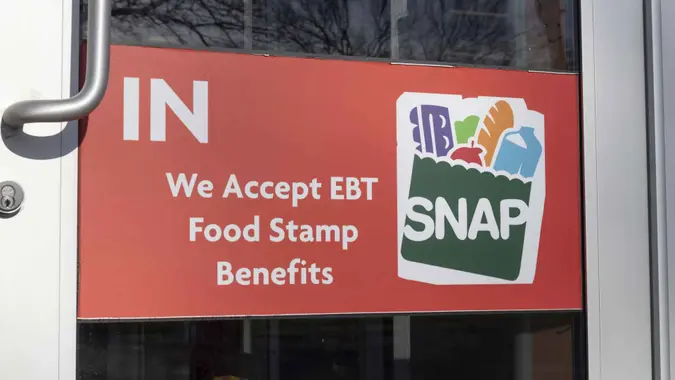Stimulus Checks May Be Gone But These 11 Government Programs Can Make Life More Affordable

Commitment to Our Readers
GOBankingRates' editorial team is committed to bringing you unbiased reviews and information. We use data-driven methodologies to evaluate financial products and services - our reviews and ratings are not influenced by advertisers. You can read more about our editorial guidelines and our products and services review methodology.

20 Years
Helping You Live Richer

Reviewed
by Experts

Trusted by
Millions of Readers
From 2020 to 2021, there were three separate stimulus checks — or Economic Impact Payments — sent out to eligible U.S. households. These checks totaled up to $3,200 per income tax filer and up to another up to $2,500 per eligible child.
Despite the rumors, there’s no sound evidence of another stimulus check coming anytime soon. This may be bad news for anyone struggling with rising costs.
The good news is that there are various state, federal and local programs that can help defray the cost of living — below are just a few.
Supplemental Nutrition Assistance Program (SNAP)
Food at home prices rose 11.4% in 2022, according to the U.S. Department of Agriculture (USDA). While that increase is astronomical, they’ve continued to rise at a slower rate ever since. By the end of 2025, they’re expected to increase by another 2.2% in 2025.
The federal SNAP program — formerly food stamps — can help low-income households offset these grocery prices. The average SNAP household gets $332 a month for eligible groceries, according to the USDA.
Women, Infants and Children (WIC) Program
The WIC program can also help with food prices. To be eligible, you must be (or have recently been) pregnant or currently breastfeeding, according to the U.S. General Services Administration (GSA). Low-income households with children under the age of five may also qualify.
Government Loans
If you meet certain household and income requirements, you could apply for government assistance in the form of a loan. Know that the government doesn’t offer grants (which are essentially free money). Anything you receive will need to be repaid.
According to the GSA, options include:
- Education loans and other financial aid for college
- Homebuying assistance programs (to help with closing or down payment costs)
- Small business loans (such as those partially guaranteed through the U.S. Small Business Administration [SBA])
Medicaid
Medicaid is a state-administered, public health insurance program designed to help individuals with healthcare costs. It’s primarily geared toward lower-income households, as well as children, seniors, pregnant women and those with qualifying disabilities.
According to KFF, Medicaid covers around 19% of total healthcare spending. Each state may offer additional coverage beyond what’s federally required, such as home care or prescription medications.
Children’s Health Insurance Program (CHIP)
CHIP helps eligible children get the healthcare coverage they need. It’s meant as a bridge for those whose incomes are too high to qualify for Medicaid, but who can’t afford private health insurance. It’s funded at the federal and state level.
Routine doctor and dental visits are free. Other healthcare costs vary, but cap out at 5% of your household’s annual income, according to the U.S. Centers for Medicare and Medicaid Services.
Social Security
You can typically start collecting Social Security at age 62, though you’ll get a higher check if you wait until the full retirement age (66 or 67, depending on year of birth), according to the IRS. The average benefit amount is just under $2,000, per the IRS.
If you need help figuring out your Social Security benefits or starting the application process, head to USA.gov. You can also check if you qualify for Social Security Disability Insurance or Supplemental Security Income.
Temporary Assistance for Needy Families (TANF)
Formerly called welfare, TANF is federally funded (but state-administered) to help low-income families afford their housing, food and home energy bills. It can even help with some manner of child support and work-related education.
Benefits and requirements vary by state and tribe.
Government Death Benefits Programs
If you’ve lost a loved one and especially if they were your household’s primary income source, you may qualify for financial aid through a government death benefits program.
Options include:
- Military benefits
- Survivor benefits (for things like housing and life insurance)
- Education assistance
Low Income Energy Assistance Program (LIHEAP)
This program is geared toward low-income households who need help with a one-time utility bill payment — either heating or cooling, according to the GSA. It’s federally funded, but each state has its own eligibility criteria.
Weatherization Assistance Program (WAP)
WAP is similar to LIHEAP, but it’s primarily meant for those who want to make energy-efficient improvements to their home. Check with your state’s WAP office to find out if you qualify based on your income. If you already receive federal aid elsewhere, you may also qualify for WAP.
Rental Assistance Programs
There are several government-run rental assistance programs, including Section 8 housing and subsidized housing, per the GSA. These are typically geared toward low-income households. Income limits are based on factors like location, family size and citizenship status.
Tips for Making the Most of Government Programs
Looking for financial assistance? Start with the following resources:
- USA.gov — home to many federal government programs
- Your local or state social service agency (for state benefits programs)
- Local non-profits, like churches, community programs
- Local food pantries
- Calling 211 (United Way’s free, confidential hotline) — 211 operators can help direct you to the resources you need
“There are structured safety nets at every level of government and within various non-profits that can help with the kind of temporary relief that can make a real difference,” said Eric Steffy of Federal Solutions Support.
Steffy suggested having certain documents when applying for financial help — like an ID, the bill you’re struggling with and proof of income or job loss.
He also suggested starting at your state’s Department of Human Services if you need help with housing, food or utilities. You may qualify for unemployment insurance, utility assistance, short- or long-term rent or mortgage assistance and more.
 Written by
Written by  Edited by
Edited by 

























